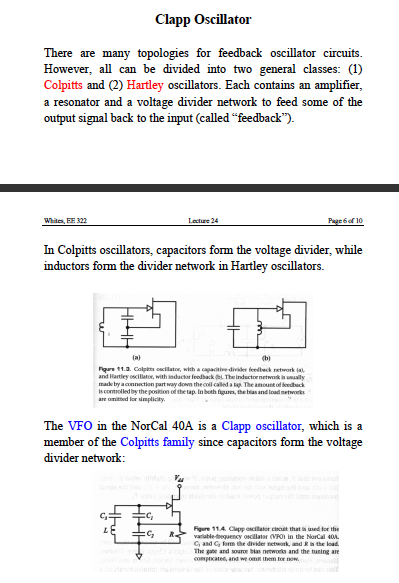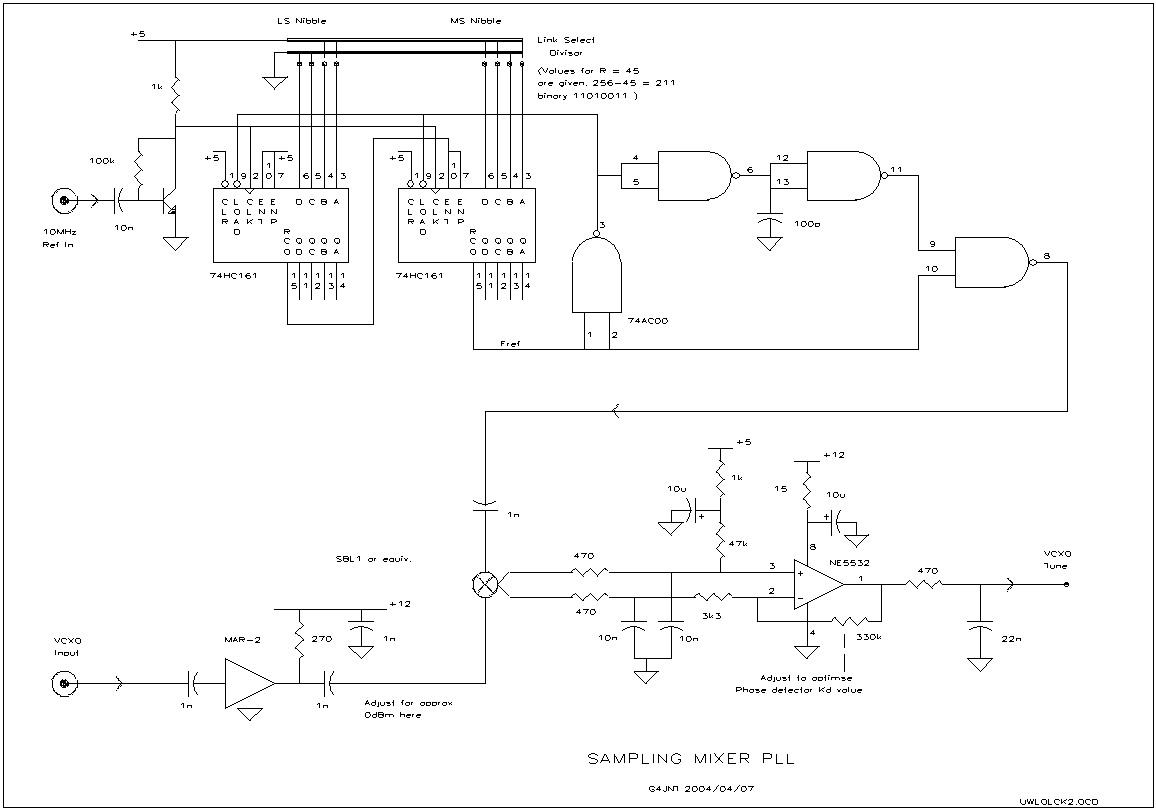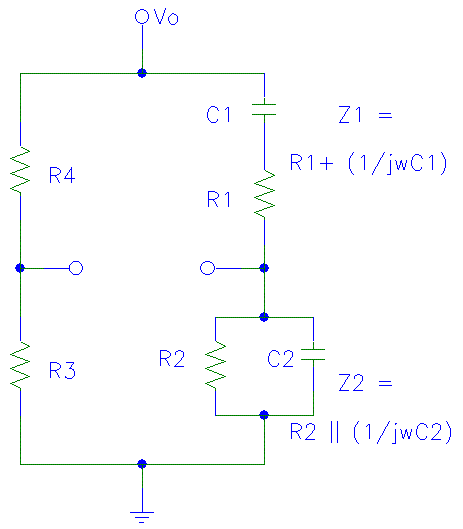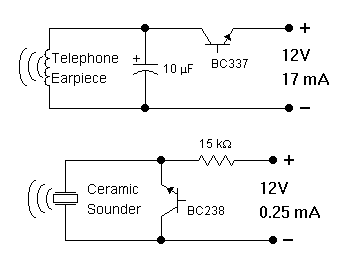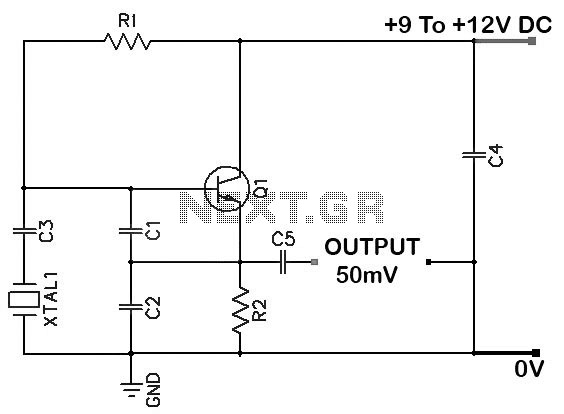
colpitts oscillators

Colpitts oscillators are similar to the shunt-fed Hartley circuit; however, the Colpitts oscillator uses two series capacitors in its LC circuit instead of a tapped inductor. The connection between these two capacitors serves as the center tap for the circuit. The simplest version of the Colpitts oscillator to construct is the "series tuned" variant, commonly known as the "Clapp Oscillator." This design yields a high "Q" circuit with a high L/C ratio and significantly reduced circulating current, which aids in drift reduction. The larger inductances required mean that stray inductances have less impact compared to other circuits. Instead of providing designs for specific frequencies, a schematic is presented that can be impedance-scaled to any frequency. The suggested reactances can be converted back to the necessary inductors and capacitances for the desired frequency band. The inductor for the Colpitts oscillator should have an impedance of approximately 250-300 ohms, with a net capacitive reactance also around the same value. The feedback capacitors, Cfb-a and Cfb-b, are each approximately 45 ohms, leading to significant values that help mitigate the capacitive effects of the transistor used. The total capacitive reactance of the parallel combination of capacitors, depicted as series tuning below the inductor in a series-tuned Colpitts or Clapp oscillator, should have a total reactance of about 200 ohms. Not all capacitors may be necessary for every application. For practical tuning examples, consider constructing an oscillator for the 40M amateur radio band, specifically 7.0 - 7.2 MHz. This frequency ratio of 1.02857 requires a modest net capacitance variation of 1.058. Using a 300-ohm inductor at 7 MHz yields a value of approximately 6.8 µH. Each Cfb at 45 ohms corresponds to 500 pF, so a value of 470 pF is suggested. The required total capacitance for resonance at 7.0 MHz is 76 pF, which slightly decreases to 71.86 pF at 7.2 MHz. In a Colpitts oscillator, all capacitors are effectively in series, meaning Cfb-a and Cfb-b are in series with the total parallel combination below the inductor. Given Cfb values of 470 pF, the parallel combination must achieve net values of 76 pF and 71.86 pF. Understanding capacitance fundamentals is crucial for solving these calculations. The maximum total capacitance of the parallel combination, Ctotal-max, occurs with the variable capacitor Cv set at maximum, while Ctotal-min is the same combination with Cv set at minimum. The series capacitor depicted with Cv may or may not be necessary, depending on the specific application. The calculations yield a Cmax of 112.3 pF and a Cmin of 103.51 pF, indicating a small variation, which may necessitate the inclusion of a series capacitor with Cv if only a relatively high value of Cv is available.
The Colpitts oscillator is a type of electronic oscillator that generates sinusoidal waveforms, commonly used in radio frequency applications. The circuit typically comprises an LC tank circuit formed by the inductor and capacitors, which determines the oscillation frequency. The feedback mechanism provided by the capacitors Cfb-a and Cfb-b is crucial for sustaining oscillations, as it ensures that a portion of the output signal is fed back into the input in phase with the original signal.
In practical applications, the selection of the inductor and capacitors is critical. The inductor's value influences both the frequency of oscillation and the circuit's quality factor (Q). A higher Q indicates lower energy loss, resulting in more stable oscillations. The capacitors, particularly the feedback capacitors, must be chosen to match the impedance requirements of the circuit while minimizing the effects of parasitic capacitance that can degrade performance.
When designing a Colpitts oscillator, it is essential to account for the operating frequency range and the desired tuning capabilities. The use of variable capacitors allows for fine-tuning of the oscillator's frequency, making it adaptable for various applications. The calculated values for capacitors and inductors must be verified through simulation or prototyping to ensure the oscillator performs as intended across the specified frequency range.
In summary, the Colpitts oscillator is a versatile and effective circuit for generating oscillations, with careful attention to component selection and circuit design being paramount to achieving optimal performance.Colpitts oscillators are somewhat similar to the shunt fed Hartley circuit except the Colpitts oscillator, instead of having a tapped inductor, utilises two series capacitors in its LC circuit. With the Colpitts oscillator the connection between these two capacitors is used as the centre tap for the circuit.
Perhaps the simplest Colpitts oscillato r to construct and get running is the "series tuned" version, more often referred to as the "Clapp Oscillator". Because there is no load on the inductor a high "Q" circuit results with a high L/C ratio and of course much less circulating current.
This aids drift reduction. Because larger inductances are required, stray inductances do not have as much impact as perhaps in other circuits. Rather than present designs for specific frequencies for the Colpitts Oscillator we have submitted a schematic which may be "impedance" scaled to any frequency.
Simply convert the suggested reactances back to the required inductor and capacitances at your band of interest. The Colpitts oscillator inductor should be around 250 - 300 ohms and the "NET" capacitive reactance should total around the same.
Feedback capacitors Cfb, both "a" and "b" are each in the region of 45 ohms leading to very large values which is very helpful in swamping out the capacitive effects of the transistor used. The total capacitive reactance of the parallel combination of capacitors depicted as series tuning below the inductor in a series tuned Colpitts oscillator or "Clapp oscillator" should have a total reactance of around 200 ohms.
Not all capacitors may be required in your particular application. Pay particular attention to our comments in Oscillator Basics. Perhaps the best approach to values used for tuning a Colpitts oscillator might be to give a practical example. Consider constructing an oscillator which tunes part of the 40M amateur radio band, 7. 0 - 7. 2 Mhz. Now that is a frquency ratio of 1. 02857 requiring a modest net capacitance variation of 1. 058. If that is not understandable go back to our basics. Using an inductor of 300 ohms at 7 Mhz for our Colpitts or Clapp oscillator yields a value of about 6.
8 uH. Each Cfb at 45 ohms works out at 500 pF so we will try 470 pF. Using an inductor of 6. 8 uH requires a total capacitance of 76 pf to resonate at 7. 0 Mhz. At 7. 2 Mhz this value has dropped down to 71. 86 pF a small variation. Effectively all the capacitors are in series in a Colpitts oscillator. That is Cfb-a and Cfb-b are each in series with the total parallel combination below the inductor. Given Cfb are each 470 pF what values are the parallel combination to achieve outcomes of net 76 pF and 71. 86 pF Had you done basics and in particular capacitance you would know the answer. We`re not being smart here just pointing out there is no such thing as a "free" lunch, you have to know "the basics".
Having done these lectures on the internet for several years, yes I`m Ian Purdie VK2TIP, I don`t appreciate email questions from lazy students expecting me to complete or provide their assignments for them. Do some work for yourself!. Back to our Colpitts oscillator, I`ll give you a "FREE" clue to the answer with these colourful formulas for the answer in figure 3.
I know a shorter method. See this example in capacitance. Here in our Colpitts oscillator Ctotal-max is the maximum of the parallel combination including the variable capacitor Cv, set at maximum while Ctotal-min is the same combination with Cv set at minimum. Clear on that Note that the other series capacitor depicted in line with Cv in figure 2 may or may not be required in your particular application.
Anyhoo! your calculations should have yielded a Cmax of 112. 3 and Cmin of 103. 51. Now that is a pretty tiny swing, so you can see the possible need for a series capacitor with Cv if all you have available is a fairly high value Cv. Let`s assume Cv is 5 - 25 pf (a variation of 20 pF) and C 🔗 External reference
The Colpitts oscillator is a type of electronic oscillator that generates sinusoidal waveforms, commonly used in radio frequency applications. The circuit typically comprises an LC tank circuit formed by the inductor and capacitors, which determines the oscillation frequency. The feedback mechanism provided by the capacitors Cfb-a and Cfb-b is crucial for sustaining oscillations, as it ensures that a portion of the output signal is fed back into the input in phase with the original signal.
In practical applications, the selection of the inductor and capacitors is critical. The inductor's value influences both the frequency of oscillation and the circuit's quality factor (Q). A higher Q indicates lower energy loss, resulting in more stable oscillations. The capacitors, particularly the feedback capacitors, must be chosen to match the impedance requirements of the circuit while minimizing the effects of parasitic capacitance that can degrade performance.
When designing a Colpitts oscillator, it is essential to account for the operating frequency range and the desired tuning capabilities. The use of variable capacitors allows for fine-tuning of the oscillator's frequency, making it adaptable for various applications. The calculated values for capacitors and inductors must be verified through simulation or prototyping to ensure the oscillator performs as intended across the specified frequency range.
In summary, the Colpitts oscillator is a versatile and effective circuit for generating oscillations, with careful attention to component selection and circuit design being paramount to achieving optimal performance.Colpitts oscillators are somewhat similar to the shunt fed Hartley circuit except the Colpitts oscillator, instead of having a tapped inductor, utilises two series capacitors in its LC circuit. With the Colpitts oscillator the connection between these two capacitors is used as the centre tap for the circuit.
Perhaps the simplest Colpitts oscillato r to construct and get running is the "series tuned" version, more often referred to as the "Clapp Oscillator". Because there is no load on the inductor a high "Q" circuit results with a high L/C ratio and of course much less circulating current.
This aids drift reduction. Because larger inductances are required, stray inductances do not have as much impact as perhaps in other circuits. Rather than present designs for specific frequencies for the Colpitts Oscillator we have submitted a schematic which may be "impedance" scaled to any frequency.
Simply convert the suggested reactances back to the required inductor and capacitances at your band of interest. The Colpitts oscillator inductor should be around 250 - 300 ohms and the "NET" capacitive reactance should total around the same.
Feedback capacitors Cfb, both "a" and "b" are each in the region of 45 ohms leading to very large values which is very helpful in swamping out the capacitive effects of the transistor used. The total capacitive reactance of the parallel combination of capacitors depicted as series tuning below the inductor in a series tuned Colpitts oscillator or "Clapp oscillator" should have a total reactance of around 200 ohms.
Not all capacitors may be required in your particular application. Pay particular attention to our comments in Oscillator Basics. Perhaps the best approach to values used for tuning a Colpitts oscillator might be to give a practical example. Consider constructing an oscillator which tunes part of the 40M amateur radio band, 7. 0 - 7. 2 Mhz. Now that is a frquency ratio of 1. 02857 requiring a modest net capacitance variation of 1. 058. If that is not understandable go back to our basics. Using an inductor of 300 ohms at 7 Mhz for our Colpitts or Clapp oscillator yields a value of about 6.
8 uH. Each Cfb at 45 ohms works out at 500 pF so we will try 470 pF. Using an inductor of 6. 8 uH requires a total capacitance of 76 pf to resonate at 7. 0 Mhz. At 7. 2 Mhz this value has dropped down to 71. 86 pF a small variation. Effectively all the capacitors are in series in a Colpitts oscillator. That is Cfb-a and Cfb-b are each in series with the total parallel combination below the inductor. Given Cfb are each 470 pF what values are the parallel combination to achieve outcomes of net 76 pF and 71. 86 pF Had you done basics and in particular capacitance you would know the answer. We`re not being smart here just pointing out there is no such thing as a "free" lunch, you have to know "the basics".
Having done these lectures on the internet for several years, yes I`m Ian Purdie VK2TIP, I don`t appreciate email questions from lazy students expecting me to complete or provide their assignments for them. Do some work for yourself!. Back to our Colpitts oscillator, I`ll give you a "FREE" clue to the answer with these colourful formulas for the answer in figure 3.
I know a shorter method. See this example in capacitance. Here in our Colpitts oscillator Ctotal-max is the maximum of the parallel combination including the variable capacitor Cv, set at maximum while Ctotal-min is the same combination with Cv set at minimum. Clear on that Note that the other series capacitor depicted in line with Cv in figure 2 may or may not be required in your particular application.
Anyhoo! your calculations should have yielded a Cmax of 112. 3 and Cmin of 103. 51. Now that is a pretty tiny swing, so you can see the possible need for a series capacitor with Cv if all you have available is a fairly high value Cv. Let`s assume Cv is 5 - 25 pf (a variation of 20 pF) and C 🔗 External reference
